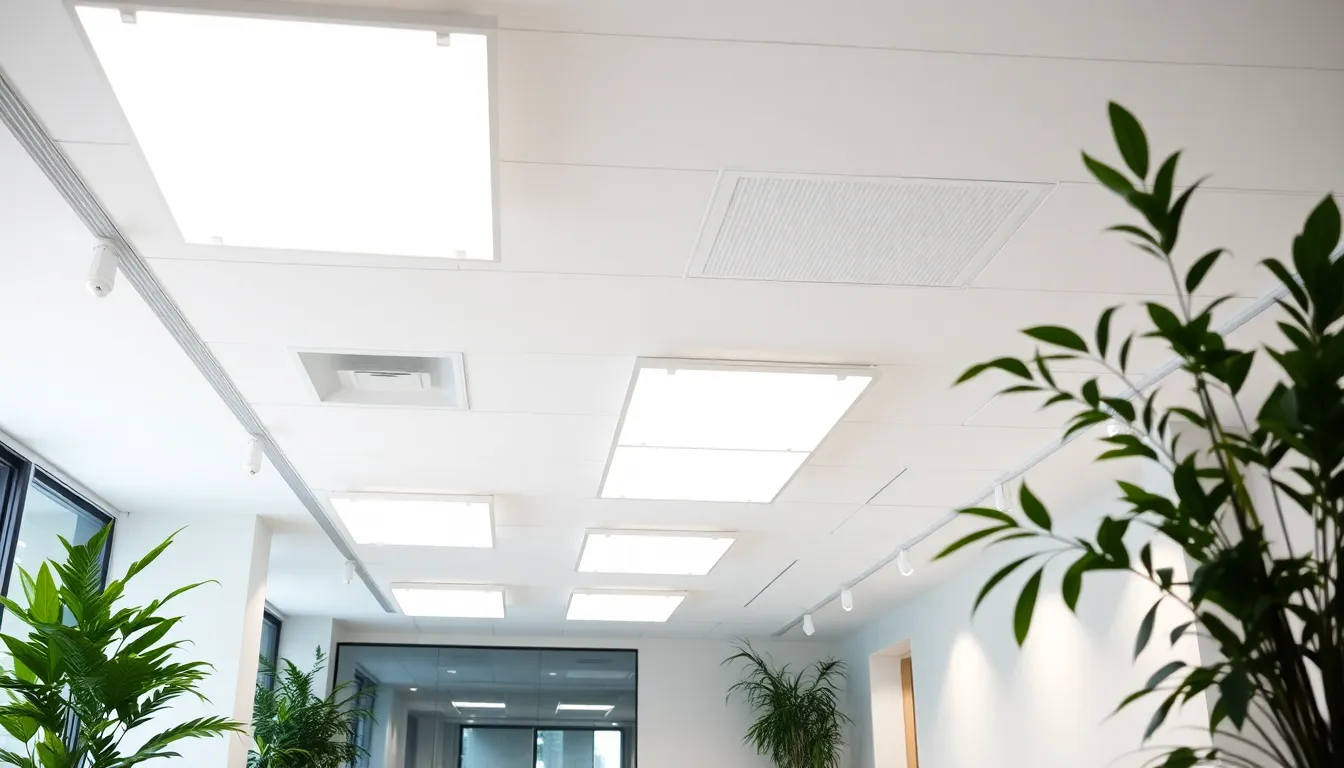Table of Contents
ToggleIn a world where lighting can make or break the vibe, LED panel lights are the unsung heroes of illumination. They’re sleek, energy-efficient, and whisper-quiet—perfect for those moments when you need a little brightness without the buzzing of outdated bulbs. Imagine transforming your drab office or cozy living room into a radiant haven that even the sun would envy.
Overview of LED Panel Lights
LED panel lights offer a modern lighting solution for various indoor environments. They come in multiple sizes and shapes, allowing for versatility in design and fit. Due to their slim profile, these lights easily blend with ceilings, providing a seamless appearance.
Energy efficiency stands out among the benefits of LED panel lights. They consume up to 80% less energy compared to traditional lighting options, significantly reducing electricity bills. A typical LED panel light has a lifespan of up to 50,000 hours, minimizing the need for frequent replacements.
Due to their design, LED panel lights emit uniform light distribution. This feature helps reduce glare and creates a comfortable atmosphere in both workspaces and homes. Moreover, they provide instant brightness, avoiding the flicker associated with other types of lights.
Installation remains straightforward with LED panel lights. They can be mounted directly on ceilings, recessed into ceiling grids, or suspended with cables. Customizable dimming options also enhance their appeal, allowing users to adjust brightness according to preferences or specific tasks.
Applications for LED panel lights include offices, schools, hospitals, and retail spaces. They contribute to well-lit environments, enhancing productivity and overall satisfaction for occupants. Additionally, their low heat emissions contribute to a cooler indoor climate, which can further improve comfort levels.
LED panel lights combine efficiency, longevity, and aesthetic appeal, making them a preferred choice for modern illumination needs.
Benefits of LED Panel Lights

LED panel lights offer numerous advantages, making them a popular choice for modern lighting solutions. Their energy efficiency and long lifespan stand out as key benefits.
Energy Efficiency
Energy efficiency defines LED panel lights. These lights consume up to 80% less energy compared to traditional bulbs. Users notice a significant reduction in electricity bills as a result. Additional savings come from their ability to provide bright illumination without excessive energy consumption. This efficiency promotes sustainable practices, making LED panel lights an environmentally friendly option. They use advanced technology to convert a higher percentage of energy into visible light, minimizing waste. As a result, organizations and homeowners alike experience both financial and ecological benefits when choosing LED panel lights for their spaces.
Long Lifespan
Long lifespan characterizes LED panel lights, lasting up to 50,000 hours. This durability ensures fewer replacements and less maintenance over time. Businesses enjoy reduced downtime caused by burnt-out lights. Across various settings, these lights maintain performance through their extended lifespan, providing consistent quality. Many manufacturers offer warranties, reinforcing their trust in the longevity of their products. Switching to LED panel lights means less hassle and lower long-term costs for users. Moreover, the longevity helps minimize waste generated by discarded lighting products, aligning with sustainability goals in energy-efficient lighting solutions.
Types of LED Panel Lights
Different types of LED panel lights cater to various installation needs and design preferences. Understanding these options enhances the selection process for effective lighting solutions.
Recessed LED Panel Lights
Recessed LED panel lights fit into ceiling spaces, creating a clean and modern look. These fixtures occupy minimal space while providing even light distribution, which minimizes glare. Often used in commercial and residential settings, they offer versatile applications due to their sleek design. Available in multiple sizes, recessed panels can seamlessly integrate into drop ceilings or drywall. Many products feature adjustable color temperatures, ranging from warm white to cool daylight, enabling users to customize the ambiance. Their energy efficiency aligns with modern sustainability goals, ensuring significant savings on electricity bills over time.
Surface-Mounted LED Panel Lights
Surface-mounted LED panel lights attach directly to ceilings or walls, offering flexibility in a variety of environments. These fixtures serve as excellent alternatives when recessed installation isn’t feasible, making them perfect for spaces with limited ceiling depth. Various designs allow for adaptation to different architectural styles, enhancing aesthetic appeal. Available in square and rectangular shapes, surface-mounted panels provide uniform light output for improved visibility. Many options include integrated dimming features, allowing users to adjust brightness levels according to specific tasks or moods. Their straightforward installation process contributes to quick upgrades in homes, offices, or retail spaces, improving overall lighting quality efficiently.
Installation Process
Installing LED panel lights proves to be a straightforward task. Proper preparation ensures a smooth process.
Tools Required
Essential tools for installation include a power drill, screwdriver, wire stripper, tape measure, and level. Safety gear, such as gloves and goggles, helps protect during the installation process. Having a voltage tester on hand ensures the safety of electrical connections.
Step-by-Step Guide
- Turn Off Power: Ensure electricity is off before starting the installation.
- Measure Space: Use a tape measure to determine the installation area.
- Mark Installation Points: Make clear markings on the ceiling for mounting.
- Cut Opening (if recessed): Carefully cut the necessary opening in the ceiling to fit the LED panel light.
- Connect Wires: Strip wire ends and connect them securely, following the manufacturer’s instructions.
- Mount the Panel: Align the panel into the opening or attach it directly to the ceiling.
- Test Functionality: Restore power and turn on the switch to verify proper operation.
Following these steps ensures an effective installation of LED panel lights in various settings.
Applications of LED Panel Lights
LED panel lights serve various applications across different settings due to their design and efficiency.
Commercial Use
Businesses frequently utilize LED panel lights to enhance workplace environments. Offices benefit from the uniform light distribution, boosting productivity and employee satisfaction. In retail spaces, these lights provide bright, inviting illumination that showcases products effectively. Schools and hospitals appreciate the energy efficiency since overhead lighting operates for long hours. Meeting rooms often integrate dimmable LED panels to adjust lighting to enhance presentations or discussions. Strong warranties offered by many manufacturers also assure businesses of reliability over time.
Residential Use
Homeowners increasingly choose LED panel lights for versatile lighting solutions. Living rooms become cozier when illuminated with adjustable brightness settings, allowing for personalized ambiance. Kitchens benefit from even light distribution, making food preparation easier and safer. Bedrooms equipped with recessed LED panels create a more expansive feel without clutter. In hallways, surface-mounted options provide adequate light for safety while maintaining a sleek appearance. Overall, residential applications enhance comfort while promoting energy conservation.
Conclusion
LED panel lights represent a significant advancement in modern lighting solutions. Their energy efficiency and long lifespan not only reduce costs but also support sustainable practices. The versatility in design and installation options makes them suitable for a wide range of environments, from commercial spaces to residential homes.
By choosing LED panel lights, individuals and businesses can create inviting and productive atmospheres while enjoying the benefits of enhanced lighting quality. As technology continues to evolve, these lights will undoubtedly play a crucial role in shaping the future of illumination.







